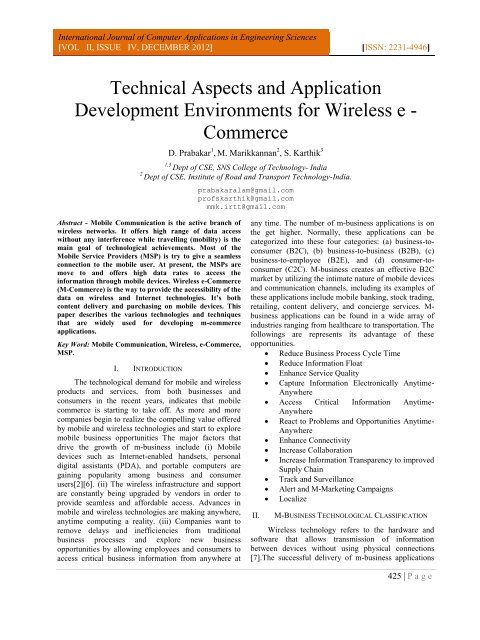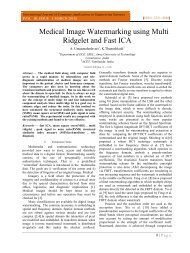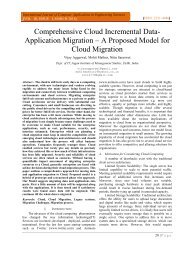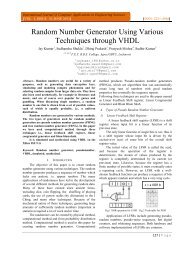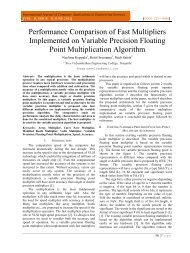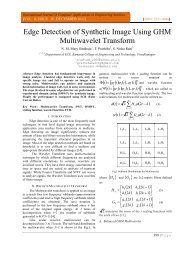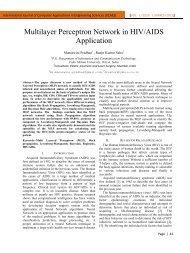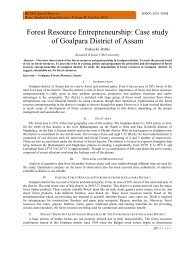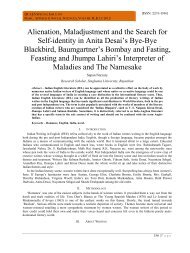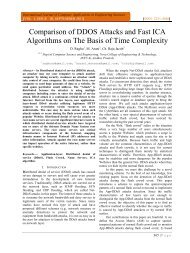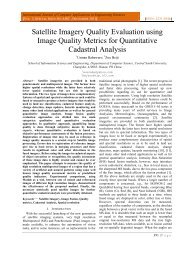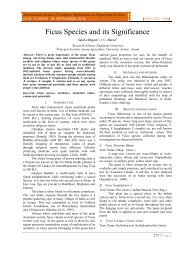Commerce - International Journal of Computer Applications in ...
Commerce - International Journal of Computer Applications in ...
Commerce - International Journal of Computer Applications in ...
You also want an ePaper? Increase the reach of your titles
YUMPU automatically turns print PDFs into web optimized ePapers that Google loves.
<strong>International</strong> <strong>Journal</strong> <strong>of</strong> <strong>Computer</strong> <strong>Applications</strong> <strong>in</strong> Eng<strong>in</strong>eer<strong>in</strong>g Sciences[VOL II, ISSUE IV, DECEMBER 2012] [ISSN: 2231-4946]Technical Aspects and ApplicationDevelopment Environments for Wireless e -<strong>Commerce</strong>D. Prabakar 1 , M. Marikkannan 2 , S. Karthik 31,3Dept <strong>of</strong> CSE, SNS College <strong>of</strong> Technology- India2Dept <strong>of</strong> CSE, Institute <strong>of</strong> Road and Transport Technology-India.prabakaralam@gmail.compr<strong>of</strong>skarthik@gmail.commmk.irtt@gmail.comAbstract - Mobile Communication is the active branch <strong>of</strong>wireless networks. It <strong>of</strong>fers high range <strong>of</strong> data accesswithout any <strong>in</strong>terference while travell<strong>in</strong>g (mobility) is thema<strong>in</strong> goal <strong>of</strong> technological achievements. Most <strong>of</strong> theMobile Service Providers (MSP) is try to give a seamlessconnection to the mobile user. At present, the MSPs aremove to and <strong>of</strong>fers high data rates to access the<strong>in</strong>formation through mobile devices. Wireless e-<strong>Commerce</strong>(M-<strong>Commerce</strong>) is the way to provide the accessibility <strong>of</strong> thedata on wireless and Internet technologies. It’s bothcontent delivery and purchas<strong>in</strong>g on mobile devices. Thispaper describes the various technologies and techniquesthat are widely used for develop<strong>in</strong>g m-commerceapplications.Key Word: Mobile Communication, Wireless, e-<strong>Commerce</strong>,MSP.I. INTRODUCTIONThe technological demand for mobile and wirelessproducts and services, from both bus<strong>in</strong>esses andconsumers <strong>in</strong> the recent years, <strong>in</strong>dicates that mobilecommerce is start<strong>in</strong>g to take <strong>of</strong>f. As more and morecompanies beg<strong>in</strong> to realize the compell<strong>in</strong>g value <strong>of</strong>feredby mobile and wireless technologies and start to exploremobile bus<strong>in</strong>ess opportunities The major factors thatdrive the growth <strong>of</strong> m-bus<strong>in</strong>ess <strong>in</strong>clude (i) Mobiledevices such as Internet-enabled handsets, personaldigital assistants (PDA), and portable computers arega<strong>in</strong><strong>in</strong>g popularity among bus<strong>in</strong>ess and consumerusers[2][6]. (ii) The wireless <strong>in</strong>frastructure and supportare constantly be<strong>in</strong>g upgraded by vendors <strong>in</strong> order toprovide seamless and affordable access. Advances <strong>in</strong>mobile and wireless technologies are mak<strong>in</strong>g anywhere,anytime comput<strong>in</strong>g a reality. (iii) Companies want toremove delays and <strong>in</strong>efficiencies from traditionalbus<strong>in</strong>ess processes and explore new bus<strong>in</strong>essopportunities by allow<strong>in</strong>g employees and consumers toaccess critical bus<strong>in</strong>ess <strong>in</strong>formation from anywhere atany time. The number <strong>of</strong> m-bus<strong>in</strong>ess applications is onthe get higher. Normally, these applications can becategorized <strong>in</strong>to these four categories: (a) bus<strong>in</strong>ess-toconsumer(B2C), (b) bus<strong>in</strong>ess-to-bus<strong>in</strong>ess (B2B), (c)bus<strong>in</strong>ess-to-employee (B2E), and (d) consumer-toconsumer(C2C). M-bus<strong>in</strong>ess creates an effective B2Cmarket by utiliz<strong>in</strong>g the <strong>in</strong>timate nature <strong>of</strong> mobile devicesand communication channels, <strong>in</strong>clud<strong>in</strong>g its examples <strong>of</strong>these applications <strong>in</strong>clude mobile bank<strong>in</strong>g, stock trad<strong>in</strong>g,retail<strong>in</strong>g, content delivery, and concierge services. M-bus<strong>in</strong>ess applications can be found <strong>in</strong> a wide array <strong>of</strong><strong>in</strong>dustries rang<strong>in</strong>g from healthcare to transportation. Thefollow<strong>in</strong>gs are represents its advantage <strong>of</strong> theseopportunities. Reduce Bus<strong>in</strong>ess Process Cycle Time Reduce Information Float Enhance Service Quality Capture Information Electronically Anytime-Anywhere Access Critical Information Anytime-Anywhere React to Problems and Opportunities Anytime-Anywhere Enhance Connectivity Increase Collaboration Increase Information Transparency to improvedSupply Cha<strong>in</strong> Track and Surveillance Alert and M-Market<strong>in</strong>g Campaigns LocalizeII.M-BUSINESS TECHNOLOGICAL CLASSIFICATIONWireless technology refers to the hardware ands<strong>of</strong>tware that allows transmission <strong>of</strong> <strong>in</strong>formationbetween devices without us<strong>in</strong>g physical connections[7].The successful delivery <strong>of</strong> m-bus<strong>in</strong>ess applications425 | P a g e
Prabakar et. al.relies on the reliability and availability <strong>of</strong> wirelessnetwork technologies. Now-a-days wireless networksolutions <strong>in</strong>clude Wireless Personal Area Networks(WPANs), Wireless Local Area Networks (WLANs),Wireless Regional Area Networks (WRANs) andWireless Wide Area Networks (WWANs).Each <strong>of</strong> thesewireless network solutions serves its unique purpose andembodies an array <strong>of</strong> attendant technologies. With awide range <strong>of</strong> mobile devices and multiple technicalplatforms coexist<strong>in</strong>g, it is important to put all these <strong>in</strong>perspective. The personal areas <strong>in</strong>clud<strong>in</strong>g <strong>of</strong>fice and anautomobile gives a traditional wireless communicationtechnology such as <strong>in</strong>frared can be found <strong>in</strong> devicesrang<strong>in</strong>g from remote controls to PDAs.Traditional wiredlocal area network (LAN); many organizations haveadopted the Wi-Fi (IEEE802.11b) technology to providewireless access to users with<strong>in</strong> a local geographical arealike as build<strong>in</strong>g, campus, airport, c<strong>of</strong>fee shop, and hotel.A WRAN technology allows peer-to-peercommunications between devices broadcast<strong>in</strong>g andpo<strong>in</strong>t-to-multipo<strong>in</strong>t communications through accesspo<strong>in</strong>ts that cover a radius <strong>of</strong> 100-500 meters. Wirelesswide area networks (WWAN) allow users tocommunicate and access resources with<strong>in</strong> a widegeographical area such as a city, a region, an entirecountry, or even around the world [3].III.COMPARISON M-BUSINESS WITH E-BUSINESSAPPLICATIONSM-bus<strong>in</strong>ess applications are entirely differ from e-bus<strong>in</strong>ess applications <strong>in</strong> many aspects; hence,develop<strong>in</strong>g m-bus<strong>in</strong>ess applications requires a differentset <strong>of</strong> tools, techniques, and strategies. Most e-bus<strong>in</strong>essapplications can’t be readily transferred to the mobileplatforms. When a company attempts to replicate theire-bus<strong>in</strong>ess success by simply mov<strong>in</strong>g its Webapplications to a wireless environment, the environment<strong>of</strong>ten fails to provide the support the applications needto be successful or usable. To successfully move a Webapplication to a wireless environment, the scope <strong>of</strong> theapplication must be redef<strong>in</strong>ed, the user <strong>in</strong>terface must beredesigned, and its network and process<strong>in</strong>g requirementsmust be reassessed.IV.TECHNICAL ASPECTS OF M-COMMERCEA. Wireless Application Protocol (WAP)The WAP, which was designed to support thedevelopment <strong>of</strong> applications over cellular networks <strong>in</strong>order to provide communication and data services for avariety <strong>of</strong> users. In 1997 Ericsson, Motorola and Nokia,along with Unwired Planet, now Openwave, formed anorganization, WAP Forum Ltd [9]. The desire was tosupport the development <strong>of</strong> wireless data services that426 | P a g ewere carrier <strong>in</strong>dependent. It <strong>of</strong>fers two k<strong>in</strong>ds <strong>of</strong> version<strong>in</strong>itially the WAP Version 1.X, <strong>of</strong> the Protocol evolvedover a period <strong>of</strong> time, add<strong>in</strong>g functionality to support theevolv<strong>in</strong>g wireless community and newer mobile devices.The latest Version WAP Version 2.0, Providesapplication environment that <strong>in</strong>cludes support for PDAs,pagers, mobile phones, and other wireless devices. TheWAP architecture provides a variety <strong>of</strong> services thatsupport the wireless transmission <strong>of</strong> text. Figure 1.1illustrates the structure <strong>of</strong> the Wireless ApplicationProtocol. Here you can see the how the various layersare implemented. Because WAP is a layered protocol,the process <strong>of</strong> transmitt<strong>in</strong>g a message from a wirelessdevice to the WAP server and back requires that themessage pass down though the layers, across thephysical carrier, and then back up the protocol stack towhere the WAP server can then place the message on tothe Internet. The reverse occurs when a message is sentby the WAP server to the wireless device.Application Layer -Wireless Application Environment (WAE)Session Layer -Wireless Session Protocol (WSP)Transaction Layer -Wireless Transaction Protocol (WTP)Security Layer –Wireless Transport Layer Security (WTLS)Transport Layer -Wireless Transport Layer(WTL)Network Layer –Wireless Network/Bearer Layer(WBL)Figure 1.1 WAP Protocol Stack.B. Wireless Markup Language (WML)WML is a markup language derived from theeXtensible Markup Language (XML). WML is designedto be used on WAP-enabled microbrowsers supportedby a variety <strong>of</strong> devices, which <strong>in</strong>clude both cell phones,and other handheld devices. WML supports theformatt<strong>in</strong>g <strong>of</strong> values and the formatt<strong>in</strong>g <strong>of</strong> outputthrough the use <strong>of</strong> a variety <strong>of</strong> methods. Text formatt<strong>in</strong>gtags are <strong>in</strong>cluded which allow for sett<strong>in</strong>g the size, theboldness, italicization, and underl<strong>in</strong><strong>in</strong>g. The use <strong>of</strong>tables helps <strong>in</strong> establish<strong>in</strong>g where the text appears on thescreen [5]. Paragraph statements are used to tie output<strong>in</strong>to a common unit, which can be formatted as desired.WMLScripts improve the use <strong>of</strong> WML documentsthrough their ability to support decision-mak<strong>in</strong>g,arithmetic operations, iteration, and parameter pass<strong>in</strong>g.
Technical Aspects and Application Development Environments for Wireless e - <strong>Commerce</strong>Furthermore, s<strong>in</strong>ce they are executed on the server, theyaid <strong>in</strong> memory management. Without any additionallanguage support, one can still write reasonably complexwireless mobile Internet applications by us<strong>in</strong>g WMLdocuments and WMLScript functions. However, toreduce the amount <strong>of</strong> work required to create usefulapplications, a set <strong>of</strong> standard libraries has beendeveloped that are easily <strong>in</strong>tegrated <strong>in</strong>to yourWMLScript functions.V. V. MOBILE APPLICATION DEVELOPMENTA. J2ME Application DevelopmentJava Platform, Micro Edition, or Java ME, is aJava platform designed for embedded systems (mobiledevices are one k<strong>in</strong>d <strong>of</strong> such systems). Target devicesrange from <strong>in</strong>dustrial controls to mobile phones and settopboxes. Java ME was formerly known as Java 2Platform, Micro Edition (J2ME).Java is knownprimarily as a server-side programm<strong>in</strong>g environment,centered on the technologies that make up the Java 2Enterprise Edition (J2EE), such as Enterprise JavaBeans(EJBs), servlets, and Java Server pages (JSPs). Earlyadopters <strong>of</strong> Java, however, will recall that it wasorig<strong>in</strong>ally promoted as a client-side applicationenvironment [1]. In fact, Java was orig<strong>in</strong>ally designed asa programm<strong>in</strong>g language for consumer appliances. NowJava is return<strong>in</strong>g to its roots with Java 2 Micro Edition,or J2ME for short.As on date, J2ME is a standardtechnology for mobile phones as <strong>in</strong> J2ME, the Javaruntime environment is adapted for constra<strong>in</strong>ed devices- devices that have limitations on their functions whencompared to standard desktop or server computers.Figure 1.2 illustrates the sample applicationdevelopment <strong>in</strong> J2ME.For low-end devices, theconstra<strong>in</strong>ts are fairly obvious: extremely limitedmemory, small screen sizes, alternative <strong>in</strong>put methods,and slow processors. High-end devices have few, if any,<strong>of</strong> these constra<strong>in</strong>ts, but they can still benefit from theoptimized environments and new programm<strong>in</strong>g<strong>in</strong>terfaces that J2ME def<strong>in</strong>es.Figure 1.2 <strong>Applications</strong> Development Us<strong>in</strong>g J2MEB. Mobile Application development us<strong>in</strong>g ColdFusionMacromedia ColdFusion as the server-sidetechnology because (1) it is becom<strong>in</strong>g one <strong>of</strong> thepredom<strong>in</strong>ant development tools for corporate Webdevelopment, and (2) it is easy to learn and use,especially for applications that <strong>in</strong>terface with databases.A server-side technology is ideal for wirelessapplications for the follow<strong>in</strong>g two reasons. First,wireless devices <strong>of</strong>ten have little process<strong>in</strong>g power.Second, server-side technology functions regardless <strong>of</strong>client devices, mak<strong>in</strong>g it possible to write once and useit anywhere [8].Figure 1.3 Macromedia ColdFusion EnvironmentsFigure1.3 shows to develop<strong>in</strong>g wireless applications forPocketPC devices and mobile handsets. While a widerange <strong>of</strong> server-side development tools can be used,Macromedia ColdFusion, a server-side technology, isused <strong>in</strong> this section to demonstrate the techniques.C. Develop<strong>in</strong>g Mobile <strong>Applications</strong> Us<strong>in</strong>g Micros<strong>of</strong>tEmbedded Visual ToolsMicros<strong>of</strong>t Embedded Visual Tools were designedto develop applications that run on W<strong>in</strong>dows CE devices(e.g., Pocket PC and Handheld PC 2000).Twoprogramm<strong>in</strong>g languages are supported by Micros<strong>of</strong>tEmbedded Visual Tools: Embedded Visual Basic (eVB)and Embedded Visual C++ (eVC)[7]. These twoprogramm<strong>in</strong>g languages are versions <strong>of</strong> Visual Basicand Visual C++ with limited capabilities, respectively.Therefore, developers with Visual Basic or Visual C++experience can easily leverage their exist<strong>in</strong>g expertise todevelop mobile or wireless applications [1]. S<strong>in</strong>ce manydevelopers are familiar with Visual Basic, we will givethe techniques <strong>of</strong> us<strong>in</strong>g eVB to develop sampleapplications for wireless devices as below mentionedFigure.1.4427 | P a g e
Prabakar et. al.Figure 1.4 Mobile Application developed <strong>in</strong> Micros<strong>of</strong>t tool.[6] Sharma, R., Morales-Arroyo, M., Tan, M., & Sangwan, S.(2008). A bus<strong>in</strong>ess network model for deliver<strong>in</strong>g onl<strong>in</strong>e contentand services on mobile platforms. Paper presented at theProceed<strong>in</strong>gs <strong>of</strong> the 7th Global Mobility Roundtable, Auckland,November.[7] Pereira, F. (2010). Visor bus<strong>in</strong>ess model framework. Retrieved17the March, 2010,fromhttp://www.marshall.usc.edu/ctm/research/visor-bus<strong>in</strong>essmodel.htm.[8] Clayton, A. L., Leonard, M. J., & Joseph, S. V. (2011).Emerg<strong>in</strong>g bus<strong>in</strong>ess models for mobile brokerage services.Communications <strong>of</strong> the ACM, 47(6), 71–77.[9] layton, A. L., Leonard, M. J., & Joseph, S. V. (2008). Emerg<strong>in</strong>gbus<strong>in</strong>ess models for mobile brokerage services.Communications <strong>of</strong> the ACM, 47(6), 71–77.VI.VI. CONCLUSIONNowadays, the most current trend is to usePDAs and mobile phones to browse the <strong>in</strong>ternet throughweb pages that are specifically formatted for wirelessdevices. Users can also conduct e-commerce on wirelessdevices by mak<strong>in</strong>g onl<strong>in</strong>e purchases and bids. F<strong>in</strong>allywe have described the overview <strong>of</strong> wireless e-<strong>Commerce</strong> and its technological aspects andapplications development us<strong>in</strong>g various language, tooland Integrated Development Environment. Mobilecommerce is creat<strong>in</strong>g a whole new mean<strong>in</strong>g for mobilephones and services. Key drivers for mobile commerceservice adoption will be ease <strong>of</strong> use and security. Fullyunderstand<strong>in</strong>g <strong>of</strong> these technologies is very important asit plays a key role <strong>in</strong> wireless technology development.Hence for future application <strong>of</strong> mobile commerce,further study <strong>in</strong> this problem is strongly recommended.428 | P a g eACKNOWLEDGMENTOur S<strong>in</strong>cere thanks to the Our SupervisorDr.M.Marikkannan, his valuable suggestion andthoughts is motivated to publish this paper and ourbeloved Dean Dr.S.Karthik, <strong>of</strong> our department <strong>of</strong>computer science and eng<strong>in</strong>eer<strong>in</strong>g, his excellence andsuggestion is very useful towards this paper.REFERENCES[1] Bouwman, H., Haaker, T., & De Vos, H. (2011). Mobile service<strong>in</strong>novation and bus<strong>in</strong>ess models. Heidelberg: Spr<strong>in</strong>ger.[2] Yuan, Y., & Zhang, J. J. (2012). Towards an appropriatebus<strong>in</strong>ess model for m-commerce. <strong>International</strong> journal <strong>of</strong>mobile communications, 1(1/2), 35–36.[3] Wong, C. C., & Hiew, P. L. (2011). Mobile enterta<strong>in</strong>ment:model development and cross services study. Paper presented atthe Proceed<strong>in</strong>gs <strong>of</strong> <strong>International</strong> Conference on ServicesSystems and Services Management.[4] Xu, G., & Gutiérrez, J. (2009). An exploratory study <strong>of</strong> killerapplications and critical success factors <strong>in</strong> m-commerce. <strong>Journal</strong><strong>of</strong> Electronic <strong>Commerce</strong> <strong>in</strong> Organizations, 4(3), 63–79.[5] Ulhøi, J., & Jørgensen, F. (2008). M-commerce exploitation: aSME bus<strong>in</strong>ess model perspective. Paper presented at theProceed<strong>in</strong>gs <strong>of</strong> the 7th Global Mobility Roundtable, Auckland.


